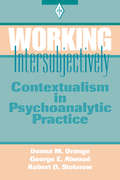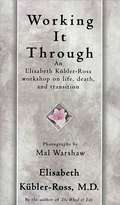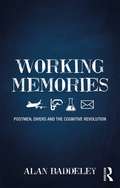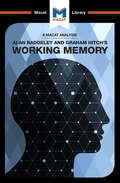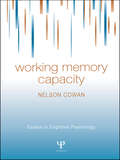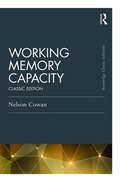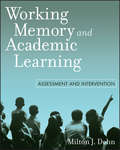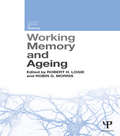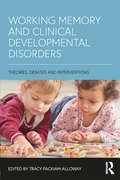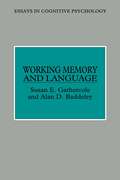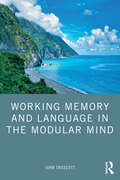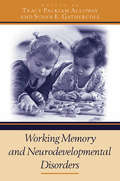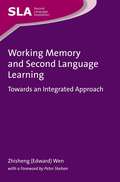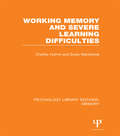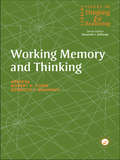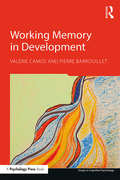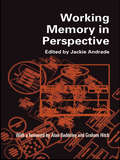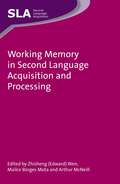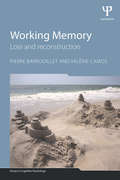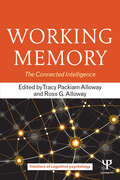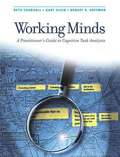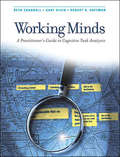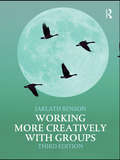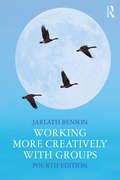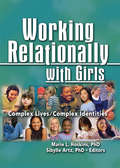- Table View
- List View
Working Intersubjectively: Contextualism in Psychoanalytic Practice (Psychoanalytic Inquiry Book Series #17)
by Donna M. Orange Robert D. Stolorow George E. AtwoodFrom an overview of the basic principles of intersubjectivity theory, Orange, Atwood, and Stolorow proceed to contextualist critiques of the concept of psychoanalytic technique and of the myth of analytic neutrality. They then examine the intersubjective contexts of extreme states of psychological disintegration, and conclude with an examination of what it means, philosophically and clinically, to think and work contextually. This lucidly written and cogently argued work is the next step in the development of intersubjectivity theory. In particular, it is a clinically grounded continuation of Stolorow and Atwood's Contexts of Being (TAP, 1992), which reconceptualized four foundational pillars of psychoanalytic theory -- the unconscious, mind-body relations, trauma, and fantasy -- from an intersubjective perspective. Working Intersubjectively expounds and illustrates the contextualist sensibility that grows out of this reconceptualization. Like preceding volumes in the Psychoanalytic Inquiry Book Series by Robert Stolorow and his colleagues, it will be theoretically challenging and clinically useful to a wide readership of psychoanalysts and psychoanalytically informed psychotherapists.
Working It Through
by Elisabeth Kubler-RossThe companion guide to Elisabeth Kübler-Ross's famous workshops on death and dying This remarkable guide to coping with death and dying grew out of Dr. Elisabeth Kübler-Ross's realization that she could help larger numbers of terminally ill people directly by meeting with them in groups. The first such meeting in 1970 led to hundreds more throughout the United States and the world and now to Working It Through, a testament to "faith and the ability to survive and transcend the most difficult trials in life" as Kübler-Ross writes in her foreword. The photographer Mal Warshaw has documented the workshops, and his moving photographs bring this already powerful book to life.
Working Memories: Postmen, Divers and the Cognitive Revolution
by Alan BaddeleyTechnological developments during the Second World War led to an approach that linked ideas from computer science to neuroscience, linguistics, philosophy and psychology, known today as the Cognitive Revolution. Leaving behind traditional behaviourist approaches popular at the time, psychology began to utilise artificial intelligence and computer science to develop testable theories and design groundbreaking new experiments. The Cognitive Revolution dramatically changed the way that psychological research and studies were conducted and proposed a new way of thinking about the mind. In Working Memories, Alan Baddeley, one of the world's leading authorities on Human Memory, draws on his own personal experience of this time, recounting the radical development of a pioneering science in parallel with his own transatlantic, vibrant and distinguished career. Detailing the excitement and sometimes frustration experienced in taking psychology into the world beyond the laboratory, Working Memories presents unique insights into the mind and psychological achievements of one of the most influential psychologists of our time.
Working Memory
by Alexander O'Connor Birgit Koopmann-HolmThe work of memory researchers Alan Baddeley and Graham Hitch is a prime example of the ways in which good critical thinkers approach questions and the problems they raise. In the 1960s, researchers into human memory began to understand memory as comprising not one, but two systems. The first was a short-term system handling information for mere seconds. The second was a long-term system capable of managing information indefinitely. They also discovered, however, that short-term memory was not simply a ‘filing cabinet,’ as many had thought, but was actively working on cognitive – or mental – tasks. This is how the phrase “working memory” developed. The hypothesis remained unproven, however, presenting Baddeley and Hitch with the problem of working out how to produce definitive evidence that short term memory was a working system that actively manipulated and processed information. They responded by designing a series of ten experiments aimed at showing just this – presenting the results in their 1974 article, ‘Working memory.’ The research was a masterpiece of problem-solving that proved revelatory. The authors not only generated new solutions and made sound decisions between alternative possibilities – they also showed that short-term memory is indeed an active system responsible for information processing and managing, while also influencing attention, reasoning, reading comprehension and learning. While their work has since been refined by others, Baddeley and Hitch’s problem-solving approach helped to create the dominant understanding of working memory that underpins psychological research throughout the world today.
Working Memory Capacity (Essays in Cognitive Psychology)
by Nelson CowanThe idea of one's memory "filling up" is a humorous misconception of how memory in general is thought to work; it is actually has no capacity limit. However, the idea of a "full brain" makes more sense with reference to working memory, which is the limited amount of information a person can hold temporarily in an especially accessible form for use in the completion of almost any challenging cognitive task. This groundbreaking book explains the evidence supporting Cowan's theoretical proposal about working memory capacity, and compares it to competing perspectives. Cognitive psychologists profoundly disagree on how working memory is limited: whether by the number of units that can be retained (and, if so, what kind of units and how many?), the types of interfering material, the time that has elapsed, some combination of these mechanisms, or none of them. The book assesses these hypotheses and examines explanations of why capacity limits occur, including vivid biological, cognitive, and evolutionary accounts. The book concludes with a discussion of the practical importance of capacity limits in daily life.Incorporating the latest from the recent surge in research into working memory capacity limits and the remarkable new insights provided by neuroimaging techniques, this book serves as an invaluable resource for all memory researchers and is accessible to a wide range of readers.
Working Memory Capacity: Classic Edition (Psychology Press & Routledge Classic Editions)
by Nelson CowanThe idea of one's memory "filling up" is a humorous misconception of how memory in general is thought to work; it actually has no capacity limit. However, the idea of a "full brain" makes more sense with reference to working memory, which is the limited amount of information a person can hold temporarily in an especially accessible form for use in the completion of almost any challenging cognitive task. This groundbreaking book explains the evidence supporting Cowan's theoretical proposal about working memory capacity, and compares it to competing perspectives. Cognitive psychologists profoundly disagree on how working memory is limited: whether by the number of units that can be retained (and, if so, what kind of units and how many), the types of interfering material, the time that has elapsed, some combination of these mechanisms, or none of them. The book assesses these hypotheses and examines explanations of why capacity limits occur, including vivid biological, cognitive, and evolutionary accounts. The book concludes with a discussion of the practical importance of capacity limits in daily life. This 10th anniversary Classic Edition will continue to be accessible to a wide range of readers and serve as an invaluable reference for all memory researchers.
Working Memory and Academic Learning
by Dehn Milton J.Equipping school and child psychologists, and neuropsychologists with critical information on the role of working memory in learning and achievement, Working Memory and Academic Learning offers guidance on assessment tools, interventions, and current evidence-based best practices. Its specific, step-by-step guidance and hands-on case studies enables you to identify how working memory relates to academic attainment and how to apply this knowledge in professional practice.
Working Memory and Ageing (Current Issues in Memory)
by Robert H. Logie Robin G. MorrisThe rapid growth in the numbers of older people worldwide has led to an equally rapid growth in research on the changes across age in cognitive function, including the processes of moment to moment cognition known as working memory. This book brings together international research leaders who address major questions about how age affects working memory: Why is working memory function much better preserved in some people than others? In all healthy adults, which aspects of working memory are retained in later years and which aspects start declining in early adulthood? Can cognitive training help slow cognitive decline with age? How are changes in brain structures, connectivity and activation patterns related to important changes in working memory function? Impairments of cognition, and particularly of working memory, can be major barriers to independent living. The chapters of this book dispel some popular myths about cognitive ageing, while presenting the state of the science on how and why working memory functions as it does throughout the adult lifespan. Working Memory and Aging is the first volume to provide an overview of the burgeoning literature on changes in working memory function across healthy and pathological ageing, and it will be of great interest to advanced undergraduates, postgraduates and researchers in psychology and related subject areas concerned with the effects of human ageing, including several areas of medicine.
Working Memory and Clinical Developmental Disorders: Theories, Debates and Interventions
by Tracy Packiam AllowayThis comprehensive volume brings together international experts involved in applying and developing understanding of Working Memory in the context of a variety of neurodevelopmental disorders, neurocognitive disorders, and depressive disorders. Each chapter provides a description of the disorder and investigates the Working Memory and related Executive Function deficits. It goes on to provide a neurological profile, before exploring the impact of the disorder in daily functions, the current debates related to this disorder, and the potential effects of medication and intervention. Through combining coverage of theoretical understanding, methods of assessment, and different evidence-based intervention programs, the book supports clinical assessment and management of poor Working Memory. It is essential reading for students in neurodevelopmental disorders, atypical development and developmental psychopathology as well as allied health professionals, clinicians and those working with children in education and healthcare settings.
Working Memory and Language (Essays in Cognitive Psychology)
by Susan E. Gathercole Alan D. BaddeleyThis book evaluates the involvement of working memory in five central aspects of language processing: vocabulary acquisition, speech production, reading development, skilled reading, and comprehension. The authors draw upon experimental, neuropsychological and developmental evidence in a wide-ranging evaluation of the contribution of two components of working memory to each aspect of language. The two components are the phonological loop, which is specialised for the processing and maintenance of verbal material, and the general-purpose processing system of the central executive.A full introduction to the application of the working memory model to normal adults, neuropsychological patients and children is provided in the two opening chapters. Non-experts within this area will find these chapters particularly useful in providing a clear statement of the current theoretical and empirical status of the working memory model. Each of the following chapters examines the involvement of working memory in one specialised aspect of language processing, in each case integrating the available experimental, neuropsychological and developmental evidence. The book will therefore be of direct relevance to researchers interested in both language processing and memory.Working Memory and Language is unique in that it draws together findings from normal adults, brain-damaged patients, and children. For each of these populations, working memory involvement in language processing ranging from the speech production to comprehension are evaluated. Working Memory and Language provides a comprehensive analysis of just what roles working memory does play in the processing of language.
Working Memory and Language in the Modular Mind
by John TruscottThe book explores two fundamental aspects of the human mind and their relation to one another. The first is the way that information is put to use in the mind. When we are doing a mental arithmetic problem, for example, how do we bring the relevant bits of information to mind and hold them there while carrying out the series of calculations? This is working memory, the subject of an enormous research literature in psychology, neuroscience, and a great many other disciplines. Characterizing the working memory process is now a major part of efforts to understand the human mind. How we characterize this process depends of course on how we characterize the human mind as a whole. In particular, is the mind made up of a number of distinct units, each carrying out a specialized function? There is considerable reason to say that it is, and this modular view of the mind has become prominent in a great deal of academic work, notably in cognitive neuroscience, with important implications for our understanding of how working memory works. But these implications have received surprisingly little consideration to this point. The aim of the book is to explore this relation between working memory and modularity, first in general terms and then using a specific modular view of the mind – the Modular Cognition Framework. The ideas are illustrated and further developed through an application to language and especially second language acquisition and use.
Working Memory and Neurodevelopmental Disorders
by Susan E. Gathercole Tracy Packiam AllowayShort-term or working memory - the capacity to hold and manipulate information mentally over brief periods of time - plays an important role in supporting a wide range of everyday activities, particularly in childhood. Children with weak working memory skills often struggle in key areas of learning and, given its impact on cognitive abilities, the identification of working memory impairments is a priority for those who work with children with learning disabilities. Working Memory and Neurodevelopmental Disorders supports clinical assessment and management of working memory deficits by summarising the current theoretical understanding and methods of assessment of working memory. It outlines the working memory profiles of individuals with a range of neurodevelopmental disorders (including Down's syndrome, Williams syndrome, Specific Language Impairment, and ADHD), and identifies useful means of alleviating the anticipated learning difficulties of children with deficits of working memory. This comprehensive and informative text will appeal to academics and researchers in cognitive psychology, neuropsychology and developmental psychology, and will be useful reading for students in these areas. Educational psychologists will also find this a useful text, as it covers the role of working memory in learning difficulties specific to the classroom.
Working Memory and Second Language Learning: Towards an Integrated Approach
by Zhisheng Edward WenThis book introduces an approach to understanding and measuring working memory components and functions in second language learning, processing and development. It presents comprehensive, thorough and updated reviews of relevant literatures from cognitive sciences and applied linguistics. Drawing on multidisciplinary research, the book advocates a conceptual framework for integrating working memory theories with second language acquisition theories. An innovative theoretical model is also presented, which illuminates research studies investigating the distinctive roles of phonological and executive working memory as they relate to specific L2 learning domains, skills and processes. Theoretical and methodological implications of this integrative perspective are further elaborated and discussed within the specific realms of L2 task-based performance and language aptitude research.
Working Memory and Severe Learning Difficulties (Psychology Library Editions: Memory)
by Charles Hulme Susie Mackenzie"Working memory" is a term used to refer to the systems responsible for the temporary storage of information during the performance of cognitive tasks. The efficiency of working memory skills in children may place limitations on the learning and performance of educationally important skills such as reading, language comprehension and arithmetic. Originally published in 1992, this monograph considers the development of working memory skills in children with severe learning difficulties. These children have marked difficulties with a wide range of cognitive tasks. The studies reported show that they also experience profound difficulties in verbal working memory tasks. These memory problems are associated with a failure to rehearse information within an articulatory loop. Training the children to rehearse material is shown to help alleviate these problems. The implications of these studies for understanding normal memory development, and for models of the structure of working memory and its development are discussed. It is argued that the working memory deficits seen in people with severe learning difficulties may contribute to their difficulties on other cognitive tasks.
Working Memory and Thinking: Current Issues In Thinking And Reasoning (Current Issues in Thinking and Reasoning)
by Robert H. Logie Kenneth GilhoolyThinking and memory are inextricably linked. However, a "divide and rule" approach has led cognitive psychologists to study these two areas in relative isolation. With contributions from some of the leading international researchers on working memory and thinking, the present volume aims to break down the scientific divisions and foster scientific integration in the connections between these two core functions of cognition. Broadly defined, thinking comprises mentally driven change in current representations. The processes involved in such change include application of logical rules, heuristics, problem solving strategies, decision making, planning and comprehension of complex material. Memory involves the encoding, retention and retrieval of information, and the retention may be temporary or in a long-term knowledge base.; Thinking cannot occur in a vacuum; it relies on the long-term memory base and a temporary mental workspace. Despite the apparent limitations on mental workspace, humans can drive a car and hold a conversation, or store partial solutions while tackling other aspects of a problem. So too, some aspects of thinking are relatively resilient in the face of quite extensive brain damage, yet other aspects are remarkably vulnerable to neuroanatomical insults. Humans can solve complex problems with many alternative choice points and yet seem to be able to consider only a few hypotheses at any one time. These apparent paradoxes present significant scientific challenges as to how humans can be such successful thinkers despite their very limited working memory. The chapters herein represent a diversity of views as regards the nature or working memory and forms of human thinking. The links between working memory and thinking are directly addressed and made explicit, and in so doing this volume offers an increasingly integrated understanding of human thinking and memory.
Working Memory in Development (Essays in Cognitive Psychology)
by Valérie Camos Pierre BarrouilletWorking memory is the system responsible for the temporary maintenance and processing of information involved in most cognitive activities, and its study is essential to the understanding of cognitive development. Working Memory in Development provides an integrative and thorough account of how working memory develops and how this development underpins childhood cognitive development. Tracing back theories of cognitive development from Piaget's most influential theory to neo-Piagetian approaches and theories pertaining to the information-processing tradition, Camos and Barrouillet show in Part I how the conception of a working memory became critical to understanding cognitive development. Part II provides an overview of the main approaches to working memory and reviews how working memory itself develops across infancy and childhood. In the final Part III, the authors explain their own theory, the Time-Based Resource-Sharing (TBRS) model, and discuss how this accounts for the development of working memory as well providing an adequate frame to understanding the role of working memory in cognitive development. Working Memory in Development effectively addresses central and debated questions related to working memory and is essential reading for students and researchers in developmental, cognitive, and educational psychology.
Working Memory in Perspective
by Jackie AndradeThe Baddeley and Hitch (1974) Working Memory model holds a central place in experimental psychology and continues to be extremely successful in guiding and stimulating research in applied and theoretical domains. Yet the model now faces challenges from conflicting data and competing theories. In this book, experienced researchers in the field address the question: Will the model survive these challenges? They explain why it is so successful, evaluate its weaknesses with respect to opposing data and theories and present their vision of the future of the model in their particular area of research. The book includes a discussion of the "Episodic Buffer" component which has recently been added to the working memory model.The result is a comprehensive and critical assessment of the working memory model and its contribution to current research in human cognition, cognitive development, neuroscience and computational modelling. Furthermore, this collection serves as a case study to illustrate the range of factors that determine the success or failure of a theory and as a forum for discussing what researchers want from scientific theories. The book begins with an accessible introduction to the model for those new to the field and explains the empirical methods used in working memory research. It concludes by highlighting areas of consensus and suggesting a programme of research to address issues of continuing controversy. Working Memory in Perspective will be a valuable resource to students and researchers alike in the fields of human memory, language, thought and cognitive development.
Working Memory in Second Language Acquisition and Processing
by Zhisheng Edward Wen Mailce Borges MotaThis unique volume offers a comprehensive discussion of essential theoretical and methodological issues concerning the pivotal role of working memory in second language learning and processing. The collection opens with a foreword and introductory theoretical chapters written by leading figures in the field of cognitive psychology. Following these are three research sections containing chapters providing original data and innovative insights into the dynamic and complex relationships between working memory and specific areas of second language processing, instruction, performance and development. Each section concludes with a commentary which is written by a noted SLA researcher and which charts the course for future research. This book provides a fascinating collection of perspectives on the relationship between working memory and second language learning and will appeal to those interested in the integration of cognitive psychology with SLA research.
Working Memory: Loss and reconstruction (Essays in Cognitive Psychology)
by Valérie Camos Pierre BarrouilletWorking memory is the cognitive system in charge of the temporary maintenance of information in view of its on-going processing. Lying at the centre of cognition, it has become a key concept in psychological science. The book presents a critical review and synthesis of the working memory literature, and also presents an innovative new theory - the Time-Based Resource-Sharing (TBRS) model. Tracing back the evolution of the concept of working memory, from its introduction by Baddeley and Hitch in 1974 and the development of their modal model, Barrouillet and Camos explain how an alternative conception could have been developed from the very beginning, and why it is needed today. This alternative model takes into account the temporal dynamics of mental functioning. The book describes a new architecture for working memory, and provides a description of its functioning, its development, the sources of individual differences, and hints about neural substrates. The authors address central and debated questions about working memory, and also more general issues about cognitive architecture and functioning. Working Memory: Loss and Reconstruction will be essential reading for advanced students and researchers of the psychology of memory.
Working Memory: The Connected Intelligence (Frontiers of Cognitive Psychology)
by Tracy Packiam Alloway Ross G. AllowayWorking memory – the conscious processing of information – is increasingly recognized as one of the most important aspects of intelligence. This fundamental cognitive skill is deeply connected to a great variety of human experience – from our childhood, to our old age, from our evolutionary past, to our digital future. In this volume, leading psychologists review the latest research on working memory and consider what role it plays in development and over the lifespan. It is revealed how a strong working memory is connected with success (academically and acquiring expertise) and a poor working memory is connected with failure (addictive behavior and poor decision-making). The contributions also show how working memory played a role in our cognitive evolution and how the everyday things we do, such as what we eat and how much we sleep, can have an impact on how well it functions. Finally, the evidence on whether or not working memory training is beneficial is explored. This volume is essential reading for students, researchers, and professionals with an interest in human memory and its improvement, including those working in cognitive psychology, cognitive neuroscience, developmental psychology, gerontology, education, health, and clinical psychology.
Working Minds
by Gary Klein Robert R. Hoffman Beth CrandallCognitive Task Analysis (CTA) helps researchers understand how cognitive skills and strategies make it possible for people to act effectively and get things done. CTA can yield information people need -- employers faced with personnel issues, market researchers who want to understand the thought processes of consumers, trainers and others who design instructional systems, health care professionals who want to apply lessons learned from errors and accidents, systems analysts developing user specifications, and many other professionals. CTA can show what makes the workplace work -- and what keeps it from working as well as it might. Working Minds is a true handbook, offering a set of tools for doing CTA: methods for collecting data about cognitive processes and events, analyzing them, and communicating them effectively. It covers both the "why" and the "how" of CTA methods, providing examples, guidance, and stories from the authors' own experiences as CTA practitioners. Because effective use of CTA depends on some conceptual grounding in cognitive theory and research -- on knowing what a cognitive perspective can offer -- the book also offers an overview of current research on cognition.The book provides detailed guidance for planning and carrying out CTA, with chapters on capturing knowledge and capturing the way people reason. It discusses studying cognition in real-world settings and the challenges of rapidly changing technology. And it describes key issues in applying CTA findings in a variety of fields. Working Minds makes the methodology of CTA accessible and the skills involved attainable.
Working Minds: A Practitioner's Guide to Cognitive Task Analysis
by Robert R. Hoffman Beth Crandall Gary A. KleinHow to collect data about cognitive processes and events, how to analyze CTA findings, and how to communicate them effectively: a handbook for managers, trainers, systems analysts, market researchers, health professionals, and others.Cognitive Task Analysis (CTA) helps researchers understand how cognitive skills and strategies make it possible for people to act effectively and get things done. CTA can yield information people need—employers faced with personnel issues, market researchers who want to understand the thought processes of consumers, trainers and others who design instructional systems, health care professionals who want to apply lessons learned from errors and accidents, systems analysts developing user specifications, and many other professionals. CTA can show what makes the workplace work—and what keeps it from working as well as it might.Working Minds is a true handbook, offering a set of tools for doing CTA: methods for collecting data about cognitive processes and events, analyzing them, and communicating them effectively. It covers both the "why" and the "how" of CTA methods, providing examples, guidance, and stories from the authors' own experiences as CTA practitioners. Because effective use of CTA depends on some conceptual grounding in cognitive theory and research—on knowing what a cognitive perspective can offer—the book also offers an overview of current research on cognition.The book provides detailed guidance for planning and carrying out CTA, with chapters on capturing knowledge and capturing the way people reason. It discusses studying cognition in real-world settings and the challenges of rapidly changing technology. And it describes key issues in applying CTA findings in a variety of fields. Working Minds makes the methodology of CTA accessible and the skills involved attainable.
Working More Creatively with Groups
by Jarlath BensonA new edition of the classic group work textbook! In Working More Creatively with Groups, Jarlath Benson presents the essential knowledge required to set up and work with a group. He looks at how to plan and lead a group successfully and how to intervene skilfully. As well as covering the different stages in the life of a group, the book emphasizes the various levels of group experience and gives suggestions for working imaginatively with them. This thoroughly updated third edition not only provides a comprehensive guide to groupwork but shows the groupworker how to move on to more in-depth and intensive work, using a variety of strategies illustrated by full clinical vignettes. Many chapters are updated and expanded to include Benson’s latest thinking and teaching and the book includes two new chapters. The first focuses on working with and developing different sorts of groups along the therapeutic/educational continuum. The second new chapter discusses how to best use a supervisory process and set up and run a supervisory group. Well known and widely used by social workers, psychologists, educationalists and youth workers, this popular text is suitable for all those working with groups.
Working More Creatively with Groups
by Jarlath BensonIn this classic text Jarlath Benson presents the basic and essential knowledge required to set up and work with a group. He looks at how to plan and lead a group successfully and how to intervene skilfully. As well as covering the different stages in the life of a group, the book emphasizes the various levels of group experience and gives suggestions for working more creatively with them. For this new edition the author has added two new chapters reflecting how his own thinking and practice have developed since the book was first published. In the first he presents his new model for planning, setting up and working with reflective practice groups which are increasingly used in professional settings and agencies across the public sector and health care. In the second he considers why some groups fail and offers practical and helpful ideas and insights to guide agencies and groupworkers to think and plan more systemically, and provides a series of clinical vignettes that facilitates each of these contexts and perspectives. There is also an expanded section on how to plan and conduct the sophisticated art of co-working and again a series of clinical vignettes that illustrate best practice. Working More Creatively with Groups is well known to countless social workers, psychologists, teachers and community workers and many other professionals who utilize and employ groupwork in their practice. This new edition not only provides the basic guide to groupwork but also shows how to move on to more in-depth and intensive work.
Working Relationally with Girls: Complex Lives/Complex Identities
by Marie L. Hoskins Sibylle ArtzDiscover how girls develop a sense of self as they struggle to make sense of complexand complicated timesWorking Relationally with Girls: Complex Lives, Complex Identities examines the experience of being a girl in today&’s society and the difficulties social work practitioners face in developing a universal theory that represents that experience. This unique book analyzes how-and why-gender is still a complicated barrier for most girls, despite living in "post-feminist" times. Working from a variety of orientations, the book offers practical suggestions on how to help girls deal with interpersonal tensions, interpersonal conflicts, relational dilemmas, and the difficulties that stem from rules and norms of what is still a male-dominated society.Human service practitioners, regardless of their fields, face an everyday struggle to understand how adolescent girls construct identities in relation to the culture in which they live. The contributors to Working Relationally with Girls call on a range of disciplines, including child and youth care, cultural studies, feminist theory, counseling, and social psychology, to examine how girls interpret cultural expectations to develop a sense of self under complex conditions. This unique book addresses the subtle-and not-so-subtle-practices (symbols, metaphors, images, scripts, rules, norms, and narratives) that shape girls&’ lives, providing the tools to build a basic framework that will help you understand how girls are alike-and how they&’re different. Working Relationally with Girls examines: how mothers and daughters perceive general differences regarding sexual experiences in adolescence how girls&’ health issues are constructed within the context of their dating relationships what do mothers and daughters want to know about each other&’s sexuality the difficulty girls have in articulating their needs and desires in romantic relationships how many girls deal with what they see as an impossible choice-compromising their sense of self to maintain a relationship or compromising the relationship to maintain their sense of self how the dynamics of a dating relationship can affect a girl&’s development and health the influence of media on constructing an identity how minorities form an identity when dealing with exclusion and belonging in a predominately white community using theater to examine the experience of identity formation and much more!Working Relationally with Girls is an essential guide to understanding how girls make sense of the world and how their decisions affect their gender and identity development. Social workers, health care professionals, child and youth care practitioners, and counselors will find this rich combination of theory and practice invaluable as an everyday resource.
